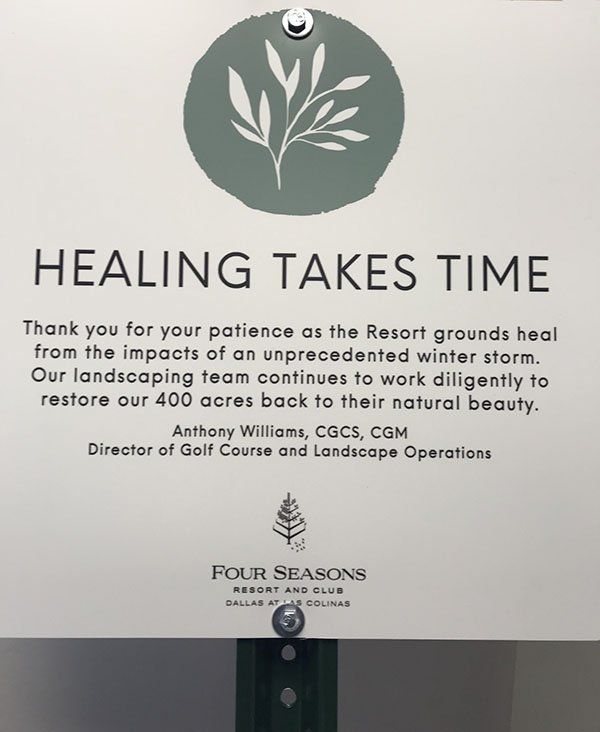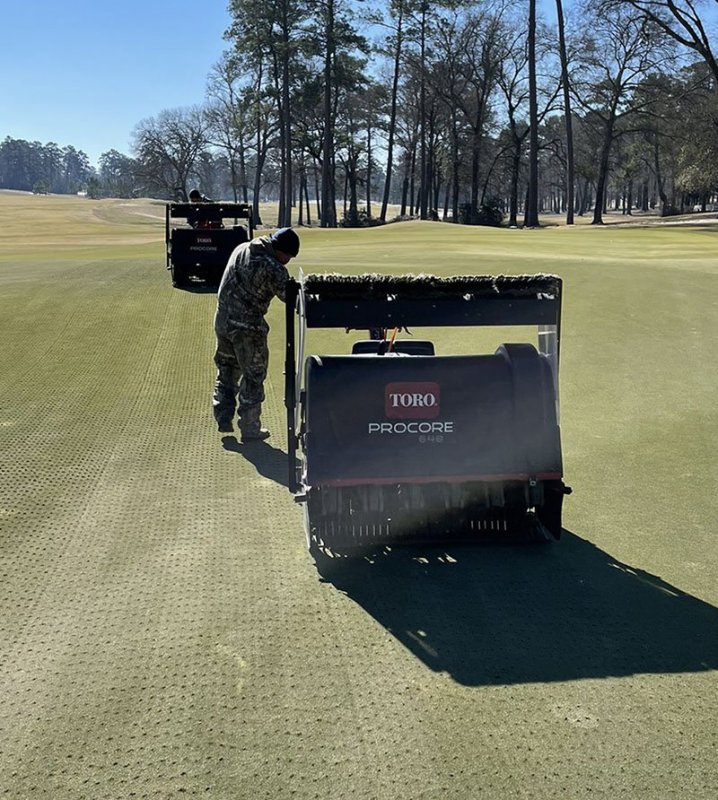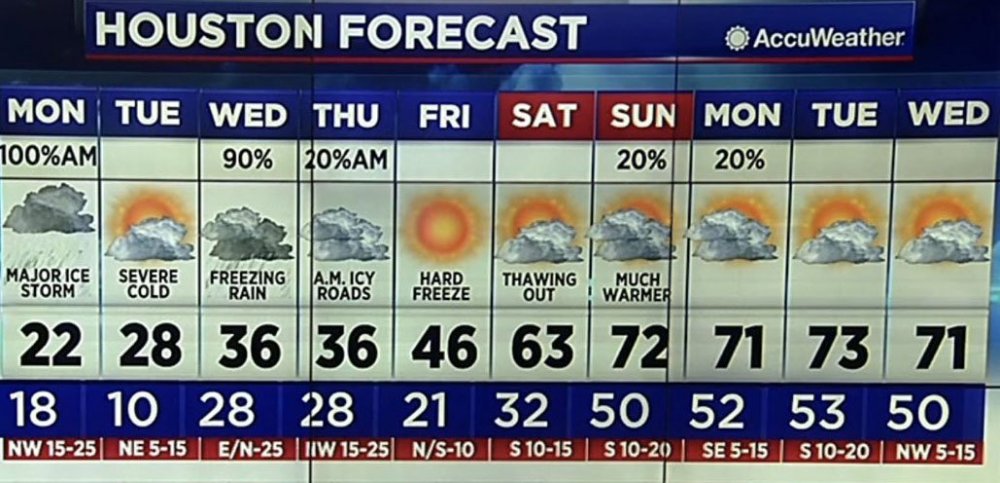Once synonymous with a 1929 gangland shooting in the back of a north side Chicago garage, the St. Valentine's Day Massacre has taken on new meaning for golf course superintendents in Texas.
It is entirely likely that before last winter there were many in the turf business in Houston for whom desiccation was such a rarity that it was relegated to urban legend status, a myth, an illusion. That changed in mid-February, when a weeklong cold snap left a trail of damage that many Texans had not seen in quite a while.
 According to local legend, it has been more than 30 years since winter damage this bad has been part of the conversation in Houston. In fact, the last time serious winter damage was an issue in this part of Texas, Kevin Cooper, who has been superintendent at Lochinvar Golf Club in Houston for the past 13 years, was a sophomore in high school in his native Flemingsburg, Kentucky.
According to local legend, it has been more than 30 years since winter damage this bad has been part of the conversation in Houston. In fact, the last time serious winter damage was an issue in this part of Texas, Kevin Cooper, who has been superintendent at Lochinvar Golf Club in Houston for the past 13 years, was a sophomore in high school in his native Flemingsburg, Kentucky.
"I have had members tell me that no one here has seen anything like this since at least 1989," Cooper said. "This is going down as a record-setting event no one has seen in a long time."
Leading up to Valentine's Day, the forecast throughout Texas called for conditions unfriendly to Bermudagrass. Temperatures flirted with the freezing mark for a week or more, depending on location, including two days in single digits in Houston and as much as minus-5 degrees Fahrenheit farther north in Dallas. On Feb. 15, the high at George Bush Airport in Houston was 25 degrees, the lowest daily high in February in Houston since 1969, according to the National Weather Service. Despite by-the-book efforts of superintendents statewide to protect putting surfaces, the result has been winter damage and desiccation from Abilene to Zavalla and everywhere in between. More than two months later, many golf courses are still playing catch up while simultaneously dealing with record amounts of play.
"Some courses fared better than others. From my standpoint, I'm fortunate I have a very understanding ownership and understanding membership," said Eric Bauer, superintendent at Bluejack National, an hour north of Houston. "My choice is to let the grass do what it needs to do to recover on its own. There is some winter injury out there, but the plant is healthy, so let it recover when the weather is favorable. We still had below-average temperatures for most of March and it started the same way in April. We're still waiting for that hot, humid weather. It just hasn't arrived yet. We don't expect to be out of this until the end of May. I feel bad for my guys. They work so hard to put out a great product, but ultimately you realize that Mother Nature is in control of everything. She definitely won."
I've removed about 3,000 shrubs and trees, and probably have at least that much more to go.
Bringing back stressed turf while hundreds of golfers day trample it daily has been a challenge.
"We're being patient and smart. We're not pushing green speeds, and we're not being overly aggressive with our cultural practices," Bauer said. "We're just trying to put out a good product, but golf is booming. Play has been unbelievable, and that makes it that much more stressful. When there is a lot of play and you're trying to recover, it's stressful."
In the Dallas area, Anthony Williams manages bentgrass greens at the TPC Four Seasons, so, overall, he has fared better than others growing Bermudagrass, but he was not immune to damage from the storm.
Like Bauer, Williams is bringing back 36 holes at the Four Seasons amid record play. Signage around the property (pictured at the top of this page) urges golfers to exercise some patience while he and he team work toward recovery.
"We've had the pandemic, closures, craziness and all of this for a whole year," Williams said. "Then there is a sense of optimism and you can't wait for spring, then we have this unparalleled winter storm. On top of that, we have had record rounds in March, and April looks like it is going to be the same."
Damage to turf has been minimal at the Four Seasons. All repair work is being completed in house, a decision made in part due to a shortage of sod and available contractors.
"We have some damage on north-facing slopes and knobs that were exposed to a north wind that came through," Williams said. "The sod supply is overtaxed, and fuel prices have gone up. If you put those two things together, not only was it the perfect winter storm, it was the perfect financial storm, as well."
In the days leading up to this year's winter anomaly, superintendents throughout the state dusted off their rarely used checklist for winter prep that included watering the greens and applying wetting agents to keep moisture in the plant and a light feeding before covering them. Both Bauer and Cooper said the process felt eerily similar to preparing for a hurricane.
Superintendents faced weather-related issues at the golf course and at home. When the weather finally arrived, much of the Houston area lost power for several days. Rolling blackouts became part of the local vernacular as utility providers tried to give everyone at least some electricity, but often that meant going days without power. Burst pipes in homes and businesses - including golf course maintenance shops and clubhouses - made a bad situation worse.
"I think a lot of people in Texas are now in agreement that they'd rather have a hurricane than a blizzard," Cooper said.
At Lochnivar, only about 15 minutes north of downtown Houston, much of the damage was confined to ornamental flower beds. Losses in ornamental beds totalled more than $100,000, but finding replacement plants - mostly wax myrtle and bottlebrush - has been difficult.
"The hardest part is finding plant material," Cooper said. "It's all shipping out of California and Florida."
I have had members tell me that no one here has seen anything like this since at least 1989. This is going down as a record-setting event no one has seen in a long time.
In Irving, Texas near Dallas, snow arrived on Valentine's Day, which was a Sunday. By Tuesday and Wednesday, temperatures overnight were below zero.
"We had nine days of killing weather. That's unheard of," Williams said. "It had been a mild winter up to that point. In my four years in Texas, we'd never had a bad winter, so I thought we were due.
"On Wednesday, it was minus-2 degrees and the wind chill was minus-18 in Dallas. Eleven days later, it was 80 degrees. I don't know how a plant can be that resilient. Superintendents were busy for days beforehand getting ready, and thank goodness they did, or it would have been much worse."
Like Cooper, Williams lost a lot of ornamentals.
"I've removed about 3,000 shrubs and trees, and probably have at least that much more to go," Williams said.
When the resort's horticulturist went to find replacement plants, the scene was surreal, according to Williams.
"There was an hour-long wait at the wholesaler, and there was an armed policeman at the gate," he said. "You could only buy so much because there was such a limited supply. We have to be creative. If you can grow areas back in, that is ideal, because there is not enough sod."
There was more damage unrelated to turf. Shifting soils resulted in the collapse of some retaining walls and partial tunnel failure.
"Temperatures were up and down so erratically and there was so much moisture," Williams said. "It was epic soil movement."
 At Bluejack, affected areas included approaches and fronts. Even under covers, the club's TifEagle greens received some damage. Although it might be another 30 years before such damage occurs again in Texas, Bauer said there were some lessons to learn this year, including multiple cover layers, or covers used in tandem with other materials.
At Bluejack, affected areas included approaches and fronts. Even under covers, the club's TifEagle greens received some damage. Although it might be another 30 years before such damage occurs again in Texas, Bauer said there were some lessons to learn this year, including multiple cover layers, or covers used in tandem with other materials.
"It is deflating to pull off the covers and feel good about everything you did to prepare and still seeing winter injury occur," Bauer said.
"We have some of the newer zoysias around greens, which is supposed to be more cold tolerant. When you see damage on zoysia, what chance did that Bermuda have?"
When the covers came off, Bauer knew he would need more time to get the course back on the road to recovery before opening it for play.
"When we took the covers off, I really wanted to aerify and get some oxygen in there," he said. I asked for an extra day to solid tine, and they gave me that (pictured at right). The frustration is what more could we have done? We prepared and we planned and we did all the right things that needed to be done to avoid catastrophe. When things don't work out that way, you wear it on your sleeve. We'll get things back to where we want them, but it won't happen overnight."
Williams, who also is a certified arborist, agreed - golfers will have to be patient to see the conditions they are accustomed to throughout Texas.
"We're going to get through this. Everyone has to have some faith and hang in there," he said.
"It was really strange to see live oaks with leaves on them and snow. Then there was a massive leaf drop. I picked up more leaves from Valentine's Day to mid-March than I did all of last year. I still have some concerns about that. If we have a hot, dry summer, casualties (among trees) won't be known for four or five months. It might really be a two-year process to find out what has to be replaced."


